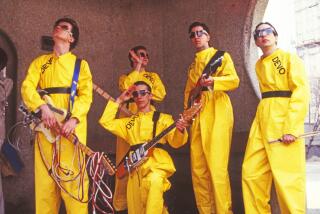The Picturesque Sound of Pere Ubu
- Share via
Is the rock world finally ready for Pere Ubu?
The critically acclaimed sextet from Cleveland, which finishes a two-night stand at Club Lingerie tonight--its first local appearance since re-forming in 1986--was a genuine punk-era innovator with its stimulating balance of gut-punch rock and unconventional sonic blasts. But so much attention was focused on the latter element during the group’s first incarnation that Pere Ubu was usually portrayed as impenetrably bizarre.
“People claimed that we are experimental or avant-garde, but Pere Ubu was never any of these things,” said vocalist David Thomas by phone from a Cleveland nightclub. “Pere Ubu is a very human-oriented group and if you want to produce music which documents the human experience as accurately as possible, that’s a very complex thing.
“People don’t actually think to themselves: ‘Oh, darling, I can’t live without you.’ Your brain doesn’t work that way. By the time you’d say, ‘Oh, dar--,’ you’re already (thinking), ‘Oh, well maybe I can,’ and a hundred other thoughts would come into your head.”
The group’s new Enigma album, “The Tenement Year,” is a return to the marvelous blend of the cerebral and visceral that marked the group’s early recordings.
Said Thomas of the band’s songwriting process: “It’s much like a sculptor looking at a block of marble and seeing what potential shapes it has and what shapes he wants it to have and making decisions where those two can meet. There’s no particular trick to the Pere Ubu sound because it’s basically 4/4. There’s no outre chord progressions or weird harmonic structures. It’s the chemistry of the people that makes the difference.”
The chemistry was rekindled when original drummer Scott Krauss dropped by a Cleveland performance by Thomas’ Wooden Birds group, which already included original Ubu members Ravenstine and bassist Tony Maimone. A jam led to the decision to join forces again, with Cleveland guitarist Jim Jones and British drummer Chris Cutler rounding out the line-up.
Pere Ubu--which took its name from a character created by absurdist French playwright Alfred Jarry--was initially conceived in 1975 as a one-shot swan song for a Cleveland underground scene.
“Pere Ubu was sort of the Crosby, Stills, Nash & Young of the Cleveland underground,” said Thomas. “Some of our ambition was to leave behind a record to be found in some Salvation Army used record bin 10 years later.
“When the music came out sounding the way it did, we recognized it had great potential for expression, and we had enough smarts not to monkey or tamper with the thing and force it into some mold. Being fairly perceptive, we also realized this was doomed from the very beginning.”
Pere Ubu released four singles on the Hearthan label before the group signed with a short-lived Mercury subsidiary for “The Modern Dance” album in 1977 and jumped to Chrysalis for “Dub Housing” in 1978. Then a 1978 tour of Britain turned Pere Ubu into an influential cult band that left a deep imprint on such individualistic British rockers as Joy Division and Julian Cope.
Pere Ubu recorded three other studio records and one live album before disbanding in 1982 to pursue individual projects.
Most of the band’s early records are out-of-print, but Rough Trade will be soon releasing the band’s entire catalogue on CD plus a new album of old live performances. The current band also just finished another studio album.
“Our principles remain unchanged,” he said. “The most important principle is that sound has inherent meaning and that sound is a visual thing. If a picture is worth a thousand words, sound is worth a thousand pictures.
“We try to do music that we would call cinematic and liken to listening to drama on the radio where sounds suggest a number of things and you have to flesh out the skeleton. The listener is actively engaged in the process--as opposed to watching television, where it’s a passive consumption.”
More to Read
The biggest entertainment stories
Get our big stories about Hollywood, film, television, music, arts, culture and more right in your inbox as soon as they publish.
You may occasionally receive promotional content from the Los Angeles Times.










